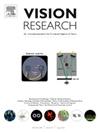光谱视网膜电图的原生成分分析
IF 1.4
4区 心理学
Q4 NEUROSCIENCES
引用次数: 0
摘要
视网膜电图(ERG)是来自视网膜所有电激活成分的大量电响应,记录的目的是识别相关成分的个体贡献,用于眼病和其他系统性医疗状况的电诊断。被测试的主要假设是,在介观强度范围内,整个光谱的ERGs可以完全用棒状和锥状通路响应线性组合的双组分模型来解释。用RETeval装置在2 Hz下测量红、黄、绿、青、蓝、品红色和白色7个光谱波段的全场方波ERGs,从3到300光cd/m2递增0.5 log单位,三名神经典型参与者的每只眼睛共有35种情况。为了克服传统线性成分分析的分布性和正交性缺点,采用了一种称为原生成分分析(NCA)的新型三阶段过程来识别对整体ERG的响应有贡献的成分。首先选取响应矩阵各区域的ERG波形。因此,它们按照a)高强度和低强度以及b)窄带红、绿、蓝光谱区域来命名。将这6种波形作为原生分量候选,以优化拟合完整数据集。第二步是确定这些定义的ERG成分与每只眼睛记录的ERG反应的总体拟合- 140个参数与10,500个参数数据集的拟合。然后将该方法与正交主成分分析(PCA)的标准方法进行比较,以提供可比的压缩。在来自三个参与者的两只眼睛的6个数据集中,新型NCA方法的前4个因素的拟合占数据总方差的95.0%,而标准PCA方法的拟合为97.5%。在最好的4个组件之外添加组件对配合没有显著的改善。对于单个数据集,PCA的拟合占方差的95.4 - 99.1%,而NCA方法的代表性ERG的拟合占个体数据集方差的89.6 - 98.1%,验证了使用代表性ERG响应作为分析成分的策略。NCA拟合强烈地否定了双杆/锥模型,即ERG只是两个时间分量的组合,表明需要多达四个单独的分量来解释参与者组中35个波形的方差,在光谱数据集中具有一致的结构。这些结果验证了新颖的原生成分分析方法在视网膜信号功能响应分析中的实用性。本文章由计算机程序翻译,如有差异,请以英文原文为准。

Native components analysis of the spectral electroretinogram
The electroretinogram (ERG) is a mass electrical response from all electrically activated components of the retina, recorded with the goal of identifying the individual contributions of relevant components for the purposes of electrodiagnosis of eye diseases and other systemic medical conditions. The primary hypothesis being tested was that the ERGs across the spectrum in the mesopic range of intensities could be fully accounted with a duplex (two-component) model of linear combinations of rod- and cone-pathway responses. Full-field square-wave ERGs were measured with the RETeval device at 2 Hz for 7 spectral bands: red, yellow, green, cyan, blue, magenta, and white, in increasing steps of 0.5 log units from 3 to 300 phot cd/m2, totaling 35 conditions for each eye of three neurotypical participants. A novel three-stage process termed Native Components Analysis (NCA), designed to overcome the distributive and orthogonality disadvantages of conventional linear component analysis, was implemented to identify the components contributing to the On-response of the overall ERG. The first step was select the ERG waveforms representative of each region of the response matrix. They were thus designated in terms of a) high and low intensities and b) the narrowband red, green and blue spectral regions. These 6 waveforms were taken as the native component candidates for an optimized fit to the full dataset. The second step was to determine the fit of these ERG components so-defined to the overall set of recorded ERG On-responses from each eye – a 140-parameter fit to the 10,500-parameter dataset. This approach was then compared with the standard approach of orthogonal Principal Components Analysis (PCA) to provide comparable compression. Over 6 datasets from the two eyes of three participants, the fit of the first 4 factors of the novel NCA approach accounted for 95.0 % of the overall variance in the data, compared with 97.5 % for the standard PCA approach. Adding components beyond the best 4 provided no significant improvement in the fits. For the individual datasets, the fit of the PCA accounted for 95.4 – 99.1 % of the variance, while the fit of the representative ERGs of the NCA approach accounted for 89.6–98.1 % of the variance across the individual datasets, validating the strategy of using representative ERG responses as the analytic components. The NCA fits strongly disconfirm the duplex rod/cone model that the ERG is a combination of just two temporal components, showing that as many as four separate components are required to account for the variance in the 35 waveforms in the participant group, with consistent structure across the spectral datasets. These results validate the utility of the novel Native Components Analysis approach to functional response analysis of retinal signals.
求助全文
通过发布文献求助,成功后即可免费获取论文全文。
去求助
来源期刊

Vision Research
医学-神经科学
CiteScore
3.70
自引率
16.70%
发文量
111
审稿时长
66 days
期刊介绍:
Vision Research is a journal devoted to the functional aspects of human, vertebrate and invertebrate vision and publishes experimental and observational studies, reviews, and theoretical and computational analyses. Vision Research also publishes clinical studies relevant to normal visual function and basic research relevant to visual dysfunction or its clinical investigation. Functional aspects of vision is interpreted broadly, ranging from molecular and cellular function to perception and behavior. Detailed descriptions are encouraged but enough introductory background should be included for non-specialists. Theoretical and computational papers should give a sense of order to the facts or point to new verifiable observations. Papers dealing with questions in the history of vision science should stress the development of ideas in the field.
 求助内容:
求助内容: 应助结果提醒方式:
应助结果提醒方式:


